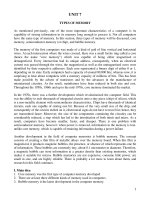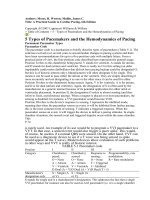Types of rocks
Bạn đang xem bản rút gọn của tài liệu. Xem và tải ngay bản đầy đủ của tài liệu tại đây (1.67 MB, 27 trang )
Three Types of Rocks
How are igneous rocks classified?
Igneous rocks (ig nee us) are formed from
magma or lava. Igneous means fire-formed.
Igneous rocks are classified according to
their origin, texture, and mineral
composition.
The origin of a rock is where the rock was
formed.
Extrusive Rocks: igneous rocks which formed
from lava which erupted on the earth’s surface.
Ex. Basalt: forms most of the crust which
includes the crust on the ocean floor.
Intrusive Rocks: igneous rocks that formed when
magma hardened beneath the earth’s surface.
Ex. Granite: the most abundant intrusive rock in
the part of the crust that makes up the
continents. Granite forms the core of many
mountain ranges
Texture
The texture of an igneous rock depends on the
size and shape of its mineral crystals.
The texture may be fine grained, coarsegrained, glassy, or porphyritic.
Rapid cooling lava forms fine-grained igneous
rocks with small crystals.
Slow cooling magma forms coarse-grained rock
with large crystals.
A rock with large crystals scattered on a
background of much smaller crystals has a
porphyritic texture (pawr fuh rit ik).
Porphyritic rocks form when intrusive rocks cool
in two stages. As the magma begins to cool,
large crystals form slowly. The remaining
magma, however, cools more quickly, forming
small crystals.
Extrusive rocks have a fine grained or glassy
texture.
Mineral Composition
Most of Earth's minerals contain silica, a
material formed from oxygen and silicon.
The silica content of magma and lava affects
the types of rock they form.
Lava that is low in silica usually forms darkcolored rocks such as basalt.
Magma that is high in silica usually forms lightcolored rocks, such as granite.
Observing
You can learn about a rock's mineral
composition by looking at a thin slice.
1. The diagram shows a thin slice of an
igneous rock. The key identifies
different minerals. Which mineral makes
up most of this rock? How did you
decide?
2. Which mineral is present in the
smallest amount?
From Sediment to Rock
Sedimentary rocks form from particles
deposited by water and wind. These particles
are called sediment.
Sediment are small, solid pieces of material
that come from rocks or living things.
Erosion occurs when running water or wind
loosen and carry away these fragments of
rock.
The moving water or wind slows and deposits
the sediment.
After sediment has been deposited, the
processes of compaction and cementation
change the sediment into sedimentary rock.
Sediment may include shells, bones, leaves,
stems, and other remains of living things.
Over time, any remains of living things in the
sediment may slowly harden and change into
fossils trapped in the rock.
Sedimentary Rock Formation Sedimentary rocks form through the deposition,
compaction, and cementation of sediments. A. Water or wind deposits sediment.
B. The heavy sediments press down on the layers beneath. C. Dissolved minerals
flow between the particles and cement them together.
At first the sediments fit together loosely. But
gradually, over millions of years, thick layers of
sediment build up. These layers are heavy and press
down on the layers beneath them. Then compaction
occurs. Compaction is the process that presses
sediments together.
While compaction is taking place, the minerals in the
rock slowly dissolve in the water. The dissolved minerals
seep into the spaces between particles of sediment.
Cementation is the process in which dissolved minerals
crystallize and glue particles of sediment together.
There are three major groups of sedimentary
rocks: clastic rocks, organic rocks, and
chemical rocks.
Clastic Rocks
Clastic rocks form when rock fragments are
squeezed together.
Ex. shale, sandstone, conglomerate and breccia
Usually occurs under water.
Shale forms from tiny particles of clay.
Sandstone forms from the sand on beaches, on the
ocean floor, in riverbeds, and in sand dunes.
Sandstone is a clastic rock formed from the
compaction and cementation of small particles of sand.
Some sedimentary rocks contain a mixture of rock
fragments of different sizes. The fragments can
range in size from sand and pebbles to boulders. If
the fragments have rounded edges, they form a
clastic rock called conglomerate. A rock made up of
large fragments with sharp edges is called breccia
(brech ee uh).
Shale
Conglomerate
Sandstone
Breccia
Organic Rocks
Forms where the remains of plants and animals
are deposited in thick layers.
The term “organic” refers to substances that
once were part of living things or were made
by living things.
Two important organic sedimentary rocks are
coal and limestone.
Coal
Coal forms from the
remains of swamp
plants buried in
water. As layer upon
layer of plant
remains build up, the
weight of the layers
squeezes the
decaying plants.
Over millions of
years, they slowly
change into coal.
Limestone
How does limestone form? In
the ocean, many living things,
including coral, clams, oysters,
and snails, have shells or
skeletons made of calcite.
When these animals die, their
shells pile up as sediment on
the ocean floor.
Slowly, the pressure of
overlying layers compacts the
sediment. Some of the shells
dissolve, forming a solution of
calcite that seeps into the
spaces between the shell
fragments. Later, the
dissolved material comes out
of solution, forming calcite.
The calcite cements the shell
particles together, forming
limestone.
Chemical Rocks
Chemical rock forms when minerals that are
dissolved in a solution crystallize.
Chemical rocks can also form from mineral
deposits left when seas or lakes evaporate.
Rock salt is a chemical rock made of the
mineral halite, which forms by evaporation.
Examples of chemical rocks
Gypsum
The word metamorphic comes from the Greek
words meta, meaning “change,” and morphosis,
meaning “form.”
Heat and pressure deep beneath Earth's
surface can change any rock into metamorphic
rock.
When rock changes into metamorphic rock, its
appearance, texture, crystal structure, and
mineral content change.
While metamorphic rocks are forming, high
temperatures change the size and shape of
the grains, or mineral crystals, in the rock.
In addition, tremendous pressure squeezes
rock so tightly that the mineral grains may
line up in flat, parallel layers.
Geologists classify metamorphic rocks by the
arrangement of the grains that make up the
rocks.
Metamorphic Rocks Great heat and pressure
can change one type of rock into another.
Granite becomes gneiss, shale becomes slate,
and sandstone changes to quartzite.
Metamorphic rocks that have their grains
arranged in parallel layers or bands are said to
be foliated. Ex. Slate, schist, gneiss
Gneiss
Slate
Schist









